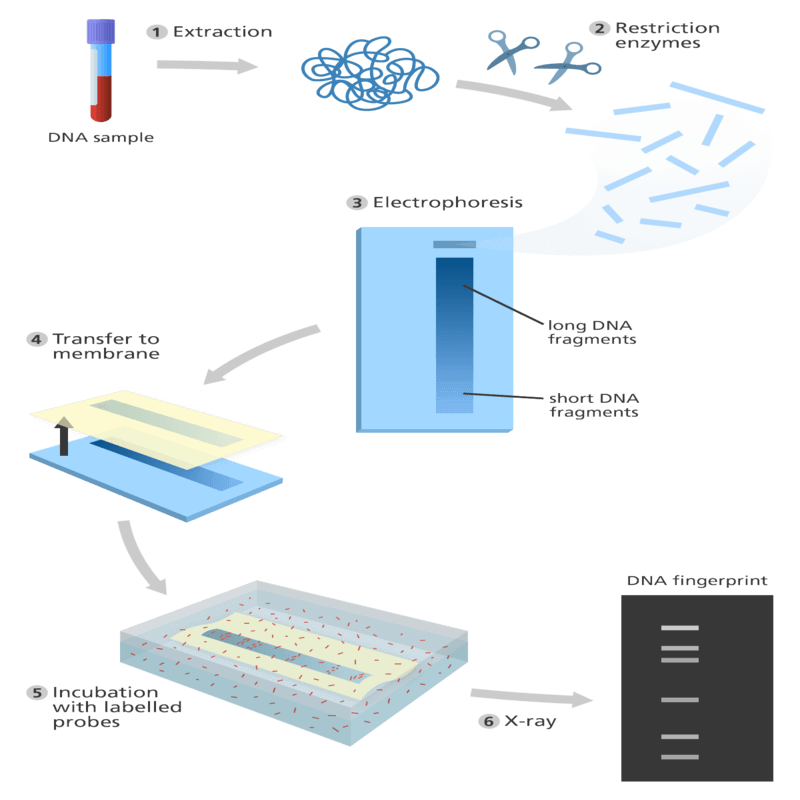 DNA fingerprinting is a chemical test that shows the genetic makeup of a person or other living things. It’s used as evidence in courts, to identify bodies, track down blood relatives, and look for cures for diseases. Read here to learn the significance of DNA fingerprinting.
DNA fingerprinting is a chemical test that shows the genetic makeup of a person or other living things. It’s used as evidence in courts, to identify bodies, track down blood relatives, and look for cures for diseases. Read here to learn the significance of DNA fingerprinting.
Since the development of fingerprinting a century ago, one of the greatest technological advances in criminal investigation has been DNA analysis.
DNA profiling techniques used to analyze biological evidence will undoubtedly link the guilty and eliminate an innocent individual.
When DNA profiling is carried out properly, the results are extremely replicable, conclusive, and able to establish a relationship between the crime and the guilty party.
When DNA testing is done properly, the results are highly replicable and convincing enough to establish the suspect’s guilt or innocence beyond a reasonable doubt.
Numerous forensic analytical procedures, including paternity testing, murder, rape, individualization, etc., use DNA fingerprinting or profiles.
DNA Fingerprinting
DNA fingerprinting is a laboratory technique used to determine the probable identity of a person based on the nucleotide sequences of certain regions of human DNA that are unique to individuals.
The nucleotide sequences of specific human DNA segments, known as repetitive DNA, which are specific to each person, are used as the basis for the laboratory procedure known as DNA fingerprinting to ascertain a person’s probable identification.
DNA fingerprinting was invented in 1984 by Professor Sir Alec Jeffreys after he realized you could detect variations in human DNA, in the form of minisatellites.
- It is a technique that simultaneously detects lots of minisatellites in the genome to produce a pattern unique to an individual. This is a DNA fingerprint.
Lalji Singh is the father of DNA fingerprinting in India.
- He developed DNA fingerprinting for crime investigations at the Centre for Cellular and Molecular Biology (CCMB) in Hyderabad in 1988.
- In 1989, DNA fingerprinting was first used in a case by Kerala Police.
What is DNA?
DNA is short for deoxyribonucleic acid, which is inside of every cell in your body. It’s a chain of chemical compounds that join together to form permanent blueprints for life.
- These compounds are called bases, and there are 4 of them- adenine (A), thymine (T), guanine (G), and cytosine (C).
- They pair up with one another to form what are called base pairs (A-T and C-G). Your DNA has about 3 billion of these couples. The way they’re strung together tells your cells how to make copies of each other.
The complete set of your compounds is known as a genome.
- More than 99.9 % of everyone’s genome is exactly alike (100% if you are identical twins).
- But the tiny bit that’s not is what makes you physically and mentally different from someone else.
Minisatellites
- Minisatellites are short sequences (10-60 base pairs long) of repetitive DNA that show greater variation from one person to the next than other parts of the genome.
- This variation is exhibited in the number of repeated units or ‘stutters’ in the minisatellite sequence.
- The first minisatellite was discovered in 1980.
DNA Profiling
- Modern-day DNA profiling is also called STR analysis and relies on microsatellites rather than the minisatellites used in DNA fingerprinting.
- Microsatellites, or short tandem repeats (STRs), are the shorter relatives of minisatellites usually two to five base pairs long.
- Like minisatellites, they are repeated many times throughout the human genome, for example, ‘TATATATATATA’.
- You get half of your DNA from your mother and a half from your father, hence STRs are passed down from parents to their children.
How is DNA fingerprinting done?

DNA fingerprinting uses chemicals to separate strands of DNA and reveal the unique parts of your genome.
The results show up as a pattern of stripes that can be matched against other samples.
To get your DNA fingerprint, you would give a sample of cells from your body.
- This can come from a swab inside your mouth, from your skin, the roots of your hair, or your saliva, sweat, or other body fluids.
- Blood is usually the easiest way.
- Lab technicians treat the sample with chemicals to separate the DNA, which is then dissolved in water.
Applications of DNA Fingerprinting
It is mostly used in court cases and legal matters related to crime or disputes. It can be used to:
- Physically connect a piece of evidence to a person or rule out someone as a suspect.
- Show who your parents, siblings, and other relatives may be.
- Identify a dead body that’s too decomposed to be recognizable.
- Match tissues of organ donors with those of people who need transplants.
- Identify diseases that are passed down through your family.
- Help find cures for those diseases, called hereditary conditions.
DNA profiles are very useful in forensics because only a tiny sample of human material left behind after a crime may be sufficient to identify someone.
The UK was the first country to set up a national database of DNA profiles in 1995.
DNA fingerprinting in agriculture
- The DNA fingerprinting technique is used with traditional genetic analysis of family pedigrees and breeding data to identify DNA markers that are inherited along with important traits. This process is sometimes referred to as marker-assisted selection.
- Recombinant DNA has improved plant growth by increasing nitrogen fixation efficiencies, cloning bacterial genes, and inserting them into plant cells.
- Other plants have been engineered to be resistant to caterpillars, pests, and viruses by inserting resistant genes into plant genomes.
DNA Fingerprinting in India
The Centre for DNA Fingerprinting and Diagnostics (CDFD) is an Indian biotechnology research center, located in Hyderabad, India, operated by the Department of Biotechnology, Ministry of Science and Technology, Government of India.
The Constitution under Article 51A(h) and (j) casts a duty upon the citizens to develop scientific temper, humanism, and the spirit of Inquiry and reform to strive towards excellence in individual and collective activity, and thereby the parliament can legitimately undertake and promote technical and scientific methods to expedite the criminal justice system as provided under the union list.
Section 9 of the Indian Evidence Act, of 1872 act deals with ‘facts necessary to explain or introduce a fact in issue or relevant fact’.
In special cases, such as Rape, the CrPC vide Section 53-A has provided that an accused of rape can be examined by a medical practitioner, which may include the collection of bodily substances from the accused for DNA fingerprinting.
Read: National Forensic Infrastructure Enhancement Scheme (NFIES)
-Article written by Swathi Satish






Leave a Reply